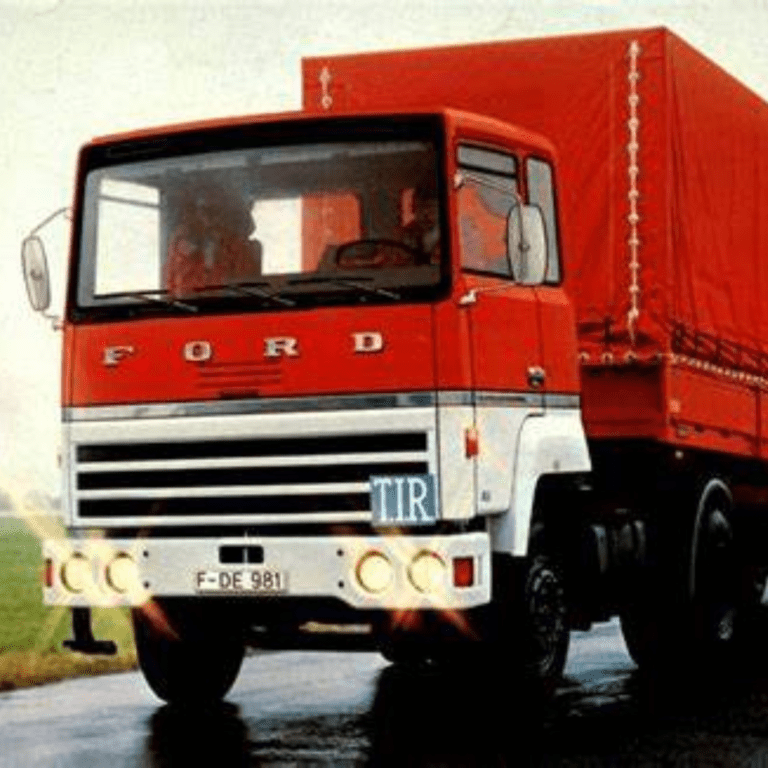Trucks with promising concepts that failed due to the impractical technology of their time.
Ford Big Red, 1964
In the 1950s, the automotive industry witnessed significant expansion, driving the quest for efficient alternatives. In this context, turbine engines emerged as a potential environmentally friendly solution, contrasting with diesel trucks.
Ford dedicated research to turbine engines, with the standout prototype being the 1964 ‘Big Red’ truck. This 600-horsepower vehicle demonstrated efficiency in transcontinental trips, supporting its viability compared to conventional diesel engines.
However, due to high operating speeds and temperatures, turbine engines were deemed impractical for automotive use. Technical and supplier issues led to Ford abandoning turbine production aspirations in 1973. While the ‘Big Red’ project didn’t materialize, the research proved valuable for emissions control in subsequent decades, utilizing materials like ceramics and high-temperature coatings.

Chevy Turbo Titan III, 1965
Featuring advanced gas turbine engine technology, deployable side lights, and a peculiar dual-dial steering, the Chevrolet Turbo Titan III was Chevrolet’s attempt to create a futuristic truck.
Designed by Bill Mitchell, the Turbo Titan III was powered by the “Whirlfire Turbo Power Engine,” boasting 280 horsepower and 875 pound-feet of torque. It had deployable headlights and turn signals, an electrically liftable cabin, and interior comforts like an FM radio, two astronaut seats, and dual-dial steering.
Although it had the same fuel efficiency as a diesel semi-trailer at 65 mph, its efficiency diminished outside that range. Despite innovative gas turbine engine technology, the introduction of the Clean Air Act, heavily regulating emissions shortly after these trucks were presented to the public, led to the withdrawal of the Chevrolet Turbo Titan III by the late 1960s.

Ford Transcontinental, 1975
Launched in mid-1975, Ford’s Transcontinental model was designed for robustness and extended durability. However, major criticisms were directed towards the cabin and suspension, with the cabin notably heavy compared to other models. The truck was designed to tow 40 tons, exceeding the UK limit of 32 tons at that time.
Its downfall came as the transport industry began facing significant challenges from 1982 due to recession and Ford’s global losses in 1980-82. Ford’s UK subsidiary took steps to mitigate losses, and the Transcontinental project was one of the sacrifices made in that process.

Pegaso Solo 500, 1988
Pegaso, an industrial vehicle brand owned by ENASA (Empresa Nacional de Autocamiones, S.A.), has disappeared today. The Pegaso Solo 500 was one of its standout models, featuring advanced technology for its time, such as cameras instead of rearview mirrors, a multifunction steering wheel with integrated buttons, and monitors on the dashboard.
The electronics of the Pegaso Solo 500 were coordinated by a central computer, eliminating much of the wiring by communicating with sensors through remote units. Alarm systems were added that, in case of malfunctions, guided the driver to the nearest workshop through a map on the monitors.
In 1992, the Pegaso Solo was adapted as a safety vehicle by adding rearview mirrors and an analog tachometer for practical reasons. Unfortunately, the vehicle fell into obscurity without seeing the light again. Currently, the current whereabouts of the vehicle are unknown.

Steinwinter Supercargo 2040, 1983
The Steinwinter Supercargo 2040 featured a cabin-under-trailer concept, similar to airport trucks. Conceived and patented by Manfred Steinwinter in the 1970s, it was presented at the 1983 Frankfurt Motor Show on a Mercedes-Benz chassis. The unusually low cabin measured 6.5 meters in length and 1.17 meters in height.
With an unconventional design, it could tow a cargo area of 18 meters in length and 150 cubic meters in volume, improving fuel efficiency due to its studied aerodynamics.
Although it was modular and offered greater maneuverability, engineers faced challenges in driving and durability, leading to the project’s cancellation due to understeer and overheating issues. Mercedes-Benz withdrew its support, putting an end to the development of the truck. Currently, its whereabouts are unknown, but it is known that it was transformed for the 1980s TV series The Highwayman.

Volvo ECT, 1996
Volvo attempted to develop the most environmentally friendly truck in history with the Volvo ECT, conceived as a precursor to future series. The goal was to create a zero-emission, low-noise vehicle through a hybrid system combining a gas turbine and an electric motor.
Additionally, a system with steering on all wheels was implemented to facilitate driving on narrow roads. Equipped with rear-view cameras, the ECT was designed with the idea that most of its components could be reused in the production of new trucks.
Although it was showcased at transport fairs, mass production never materialized. Today, Volvo Trucks stands out as a leader in adapting zero-emission vehicles.


The story of the first car race in Paris: a historic hit in 1894
Paris stands not only as a cultural and artistic epicenter but also as a pioneer in car racing In the history of automotive racing, Paris

Top states for driving in the United States in 2024
A WalletHub study compared all 50 states to determine the best driving conditions Road safety and quality are central concerns for drivers. And while the

Briefs: marijuana reclassification, vehicle fees, and climate grants
The trucking industry goes through new legislation, taxes and subsidies Questions about the proposed reclassification of marijuana The Owner-Operator Independent Drivers Association (OOIDA) supports the

Impact of traffic pollution: study reveals increase in blood pressure
A study from the University of Washington in Seattle reveals that the main cause of significant increases in blood pressure might be traffic-related gasses A

The benefits and careers of a Commercial Driver’s License
Having a CDL opens multiple doors within the trucking and transportation industry Having a Commercial Driver’s License (CDL) opens multiple doors within the trucking industry,

Sharing the road with a truck: steps to ensure your safety
Caution around blind spots and anticipating truck maneuvers are essential to ensuring everyone’s safety Truck drivers face significant challenges on the road due to their
